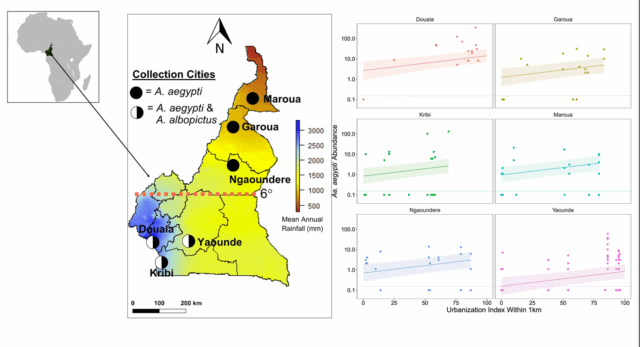
The six cities surveyed for adult mosquitoes spanned a large rainfall gradient. Above approximately 6° latitude, Ae. albopictus was not found
The global increase in urbanization, especially in Africa, will likely alter vector abundance and pathogen transmission. We investigated the effect of urbanization and weather on the abundance of two Aedes species: Aedes aegypti and Aedes albopictus, and their infection status for dengue, chikungunya, and Zika viruses in six cities spanning a 900 km latitudinal range in Cameroon, Central Africa. These cities were: Douala, Garoua, Kribi, Maroua, Ngaoundere and Yaoundé.
For this study, we used human landing catch and backpack aspirators- a portable, handheld device worn on the back, used to collect insects from surfaces- to sample mosquitoes. In addition, we collected larval habitat, host availability, and weather (temperature, precipitation, humidity) data for each site in each city. We analysed land use and land cover information and satellite photos at varying radii around sites (100 m to 2 km) to quantify the extent of urbanization and the number of structures around each site. We used a continuous urbanization index (UI) that increased with impermeable surface and decreased with forest cover.
Urbanization increased larval habitat, human host availability, and Aedes aegypti abundance. Aedes aegypti abundance also increased with rainfall. In contrast, Aedes albopictus abundance increased with urbanization in one city but showed no impact of urbanization in two other cities. Across three cities, Aedes albopictus abundance increased with rainfall, temperature, and humidity. At the end, we did not detect Zika, dengue, or chikungunya viruses in any specimens. These results show that urbanization consistently increases Aedes aegypti abundance across a broad range of habitats in Central Africa, while effects on Aedes albopictus were more variable and the abundance of both species were influenced by rainfall.
Read more: https://doi.org/10.1186/s13071-025-06764-5






